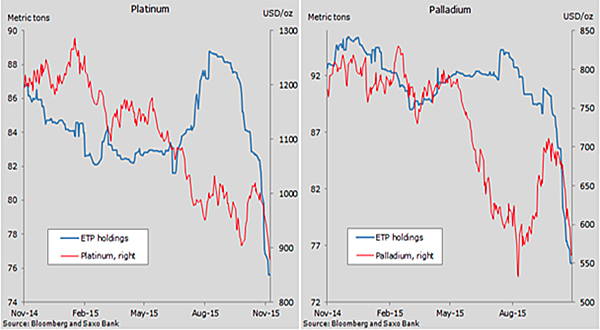
On Friday, platinum and palladium futures gave up more ground as ETF investors liquidate positions in anticipation of further falls in the precious metals complex.
In afternoon trade on the Nymex in New York platinum for delivery in January – the most active contract – lost more than $15 or 1.8% to a low of $860.50 an ounce. More than two weeks of relentless selling has seen the price of the metal decline nearly 15%, hitting its lowest since November 2008 on Friday. At the time the platinum price quickly recovered but for any sustained period trading below $900 an ounce you have to go back a decade.
Nymex contracts for December delivery of sister metal palladium exchanged hands for as little as $535 an ounce, down more than 3% and 20% over the past two weeks. Palladium has been on a wild ride reaching a 13-year highs above $900 an ounce in September last year but is now back to levels last seen mid-2010.
Apart from jewellery platinum’s main application is in autocatalysts to treat emissions, while more than 70% of palladium finds its way into vehicles. Fallout from the Volkswagen scandal, amply supply and worries about the impact on vehicle sales in the US as interest rates are lifted from near zero have weighed on PGM prices (and soaring Chinese car sales have been ignored).
But the recent sell-off is mainly being blamed on investors liquidating their holdings in physically backed exchange traded funds. The launch of two popular physically-backed palladium ETFs in Johannesburg in March last year gave an additional boost to palladium and platinum already boosted by the crippling strike in South Africa.
Now it seems South African investors can’t find the exits quickly enough with holdings falling off a cliff since August.
Ole Hansen, head of commodity strategy at Saxo Bank points out that both platinum and palladium are small markets and such a massive exodus within a short space of time can exaggerate price declines of the underlying metal:

Together Russia and South Africa control between 70% and 80% of the world’s supply of PGMs. Russia’s state stockpiling organization called Gokhran sits on an disclosed amount of palladium built up during the Soviet era, which it releases onto the market from time to time.
The structure of supply has not altered in any substantial way since the 1970s when platinum and later palladium came to the fore as an important part of the world’s automobile industry.
Comments
kef long
“(and soaring Chinese car sales have been ignored)” …. meaning that shorts are out in force using each and every journo to dissuade people from buying in …